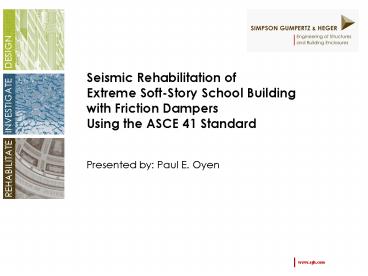Seismic Rehabilitation of Extreme SoftStory School Building with Friction Dampers Using the ASCE 41 - PowerPoint PPT Presentation
1 / 14
Title:
Seismic Rehabilitation of Extreme SoftStory School Building with Friction Dampers Using the ASCE 41
Description:
Presented by: Paul E. Oyen. Overview. Description of Building. Project Background ... Following the 1994 Northridge Earthquake, the soft-story condition is identified ... – PowerPoint PPT presentation
Number of Views:466
Avg rating:3.0/5.0
Title: Seismic Rehabilitation of Extreme SoftStory School Building with Friction Dampers Using the ASCE 41
1
Seismic Rehabilitation of Extreme Soft-Story
School Building with Friction Dampers Using the
ASCE 41 Standard
- Presented by Paul E. Oyen
2
Overview
- Description of Building
- Project Background
- Two Solution Procedures
- Code-Based
- Performance-Based (ASCE 41)
- Friction Dampers
- Comparison of Solutions
- Conclusions
3
Description of Building
- Glendale HS - Glendale, CA
- Built in 1968
- Administrative Offices Library
- Structural System
- Roof
- Concrete Slab
- Steel Girders
- 2nd Story
- Perimeter Bearing Walls
- Reinforced Masonry Concrete
- 2nd Floor
- Reinforced Concrete Pan-Joist
- 1st Story
- Reinforced Concrete Columns
- Foundation
- Drilled-piers
- 18f x 30 deep
- Groups of 2-4 _at_ each column
4
Project Background
- Following the 1994 Northridge Earthquake, the
soft-story condition is identified - In 2006, Glendale USD funds rehabilitation as
part of overall campus modernization. - Architectural requirements dictate perimeter
braces for any strengthening stiffening. - Project falls under DSA jurisdiction as a
voluntary seismic upgrade.
5
Deficiencies
- Global
- Soft-Story
- Weak-Story
- Local (Non-Ductile Detailing)
- Little confinement in columns
- Shear critical beams and columns
- No top bars in pile caps
- Partial height reinforcement in drilled-piers
6
Code-Based Solution
- Design Steps
- Size steel braces to eliminate code-defined
soft-story - Check braces for elastic design forces
- Check existing foundations for elastic design
forces - Design foundation strengthening as necessary
- Detail braces per code
- Design brace frame connections to building with W
forces - Analysis
- Linear Dynamic
- ETABS
7
Code-Based Solution
- Results
- Added (10) concentric steel braces frames
- W14x233 W14x311 braces
- Add (20) drilled piers to existing pier groups
- Add new pier groups at each of (4) corners
- Required frame to existing foundation connection
strength could not be attained.
8
Performance-Based Solution (ASCE 41)
- Design criterion
- Basic Safety Objective for structural components
- Life Safety in 10/50-yr event
- Collapse Prevention in 2/50-yr event
- Design Steps
- Define desired yield mechanism
- Add ductility to yielding components
- Add stiffness to building
- Analyze check deformation limits
- Iterate to solution
- Analysis
- Nonlinear Static (pushover)
- PERFORM-3D
9
Friction Dampers
- Two steel plates sandwiched together by
pretensioned bolts in long slotted holes - Calibrated to slip at specified axial load
- Provide elastic-perfectly- plastic behavior
- Two functions in this design
- Allow large displacements without buckling brace
- Limit force on foundation and connection to
structure - ASCE 41 does not allow added damping in pushover
analysis for friction dampers.
10
Performance-Based Solution (ASCE 41)
- Results
- Add ¼ steel jackets to (20) columns
- Add braces at each corner with friction dampers
- Friction dampers have 200-kip slip load /- 4½
displacement capacity - Selectively cut longitudinal column bars to
protect against shear failure
11
Comparison of Solutions
- Code-Based
- Conventional technology
- Elastic analysis
- 64,000 lbs of steel
- (32) new drilled piers
- Frames could not be adequately connected
- Performance-Based
- Additional testing approval required
- Nonlinear analysis required
- 30,000 lbs of steel
- (12) new drilled piers
- Predictable behavior ensured
12
Conclusions
- Prescriptive code requirements led to a costly
and infeasible solution. - Performance-based design concepts allowed for
reduced construction costs and improved seismic
performance.
13
Acknowledgements
- Skip Freet
- Craig Goings
- Ron Hamburger
- James Parker
- Jaime Rosenbach
14
- Questions?































